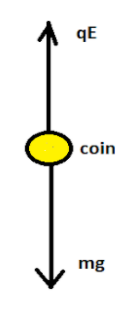Answer
38.7k+ views
Hint: In the question, it’s given that the coin is floating. The coin will float only when the net force is zero or the forces are balanced i.e. the force due to the electric field is equal to the weight of the electron. From this, we can easily calculate the charge required to balance the electron and from that, we can calculate the amount of electron which will be removed.
Formulae used:
${N_e} = \dfrac{q}{{{C_e}}}$
Here ${N_e}$ is the number of electrons, $q$ is the total charge and ${C_e}$ is the charge on one electron.
Complete step by step answer:
In the question, a coin of mass $1.6g$ is given. It is said that it is floating in the electric field of $109N{C^{ - 1}}$.
Let us draw the free body diagram of the coin.

For the coin to float it should be in a balanced condition. The upward force acting on the coin should be equal to the downward force acting on the body. Hence
$ \Rightarrow qE = mg$
Where $q$ is the net charge on the coin, $E$ is the electric field acting on the body, $m$ is the mass of the coin and $g$ is the acceleration due to gravity.
Let this be equation 1.
It’s given that,
$m = 1.6g = 1.6 \times {10^{ - 3}}kg$
$E = {10^9}N{C^{ - 1}}$
$g = 9.8m{s^{ - 2}}$
Putting the values of $m$, $E$ and $g$ in the equation 1, we get,
$ \Rightarrow q \times 109 = 1.6 \times {10^{ - 3}} \times 9.8$
$ \therefore q = \dfrac{{1.6 \times {{10}^{ - 3}} \times 9.8}}{{{{10}^9}}}$
We know that the charge on one electron is $1.6 \times {10^{ - 19}}C$.
The number of electrons that is required to be removed,
$ \Rightarrow {N_e} = \dfrac{q}{{{C_e}}}$
Here ${N_e}$ is the number of electrons, $q$ is the total charge and ${C_e}$ is the charge on one electron.
$ \Rightarrow {N_e} = \dfrac{q}{{{C_e}}}$
$ \therefore {N_e} = \dfrac{{\dfrac{{1.6 \times {{10}^{ - 3}} \times 9.8}}{{{{10}^9}}}}}{{1.6 \times {{10}^{ - 19}}C}} = 9.8 \times {10^7}$
So option (A) is the correct answer.
Note: Any charge when placed in an external electric field will experience an electric force. In this case the force experienced by all the electrons in the coin should balance the weight of the coin. We will not consider the electric force acting on the protons because this electric force acting on them is negligible as compared to the intranuclear forces inside the nucleus of the atoms. So, only the force on the electrons is considered.
Formulae used:
${N_e} = \dfrac{q}{{{C_e}}}$
Here ${N_e}$ is the number of electrons, $q$ is the total charge and ${C_e}$ is the charge on one electron.
Complete step by step answer:
In the question, a coin of mass $1.6g$ is given. It is said that it is floating in the electric field of $109N{C^{ - 1}}$.
Let us draw the free body diagram of the coin.

For the coin to float it should be in a balanced condition. The upward force acting on the coin should be equal to the downward force acting on the body. Hence
$ \Rightarrow qE = mg$
Where $q$ is the net charge on the coin, $E$ is the electric field acting on the body, $m$ is the mass of the coin and $g$ is the acceleration due to gravity.
Let this be equation 1.
It’s given that,
$m = 1.6g = 1.6 \times {10^{ - 3}}kg$
$E = {10^9}N{C^{ - 1}}$
$g = 9.8m{s^{ - 2}}$
Putting the values of $m$, $E$ and $g$ in the equation 1, we get,
$ \Rightarrow q \times 109 = 1.6 \times {10^{ - 3}} \times 9.8$
$ \therefore q = \dfrac{{1.6 \times {{10}^{ - 3}} \times 9.8}}{{{{10}^9}}}$
We know that the charge on one electron is $1.6 \times {10^{ - 19}}C$.
The number of electrons that is required to be removed,
$ \Rightarrow {N_e} = \dfrac{q}{{{C_e}}}$
Here ${N_e}$ is the number of electrons, $q$ is the total charge and ${C_e}$ is the charge on one electron.
$ \Rightarrow {N_e} = \dfrac{q}{{{C_e}}}$
$ \therefore {N_e} = \dfrac{{\dfrac{{1.6 \times {{10}^{ - 3}} \times 9.8}}{{{{10}^9}}}}}{{1.6 \times {{10}^{ - 19}}C}} = 9.8 \times {10^7}$
So option (A) is the correct answer.
Note: Any charge when placed in an external electric field will experience an electric force. In this case the force experienced by all the electrons in the coin should balance the weight of the coin. We will not consider the electric force acting on the protons because this electric force acting on them is negligible as compared to the intranuclear forces inside the nucleus of the atoms. So, only the force on the electrons is considered.
Recently Updated Pages
silver wire has diameter 04mm and resistivity 16 times class 12 physics JEE_Main

A parallel plate capacitor has a capacitance C When class 12 physics JEE_Main

Let gx 1 + x x and fx left beginarray20c 1x 0 0x 0 class 12 maths JEE_Main

A series combination of n1 capacitors each of value class 12 physics JEE_Main

When propyne is treated with aqueous H2SO4 in presence class 12 chemistry JEE_Main

Which of the following is not true in the case of motion class 12 physics JEE_Main

Other Pages
Oxidation state of S in H2S2O8 is A 6 B 7 C +8 D 0 class 12 chemistry JEE_Main

Excluding stoppages the speed of a bus is 54 kmph and class 11 maths JEE_Main

Differentiate between homogeneous and heterogeneous class 12 chemistry JEE_Main

What is the volume of water that must be added to a class 11 chemistry JEE_Main

when an object Is placed at a distance of 60 cm from class 12 physics JEE_Main

If a wire of resistance R is stretched to double of class 12 physics JEE_Main



